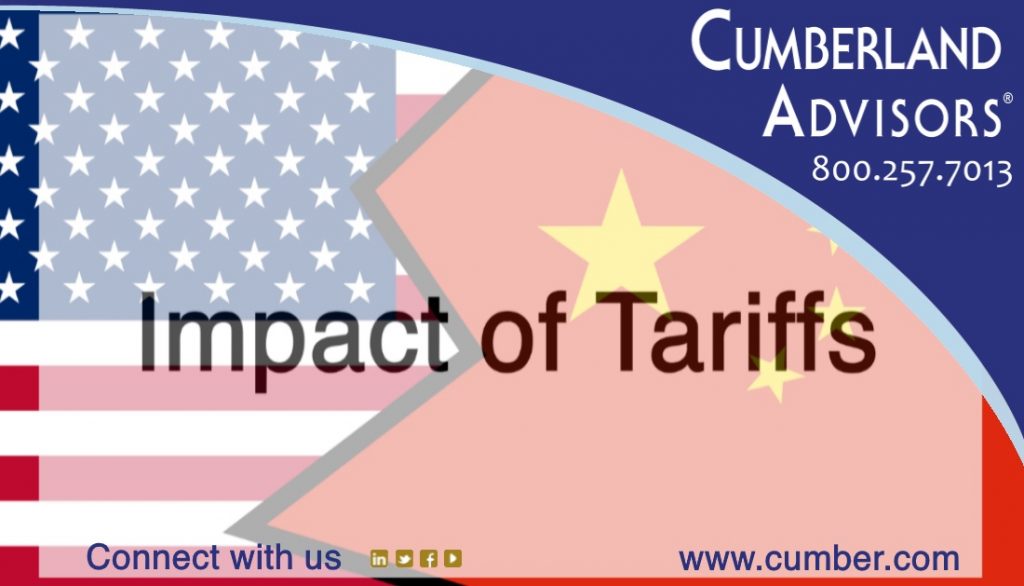Robert Brusca of FAO-Economics details some interesting information on US trade and the likely impacts that the current US-China trade war could have on prices.[1]
He has provided us with a deep dive into the mechanics and macro costs of the current tariff “war.” Here are data suggesting that markets may have overreacted to this week’s round of tariff increases and their implications for the US economy.
1) US total non-petroleum imports amount to about 9.5% of US GDP, while US imports from China, though large in dollar amount, account for about 15% of US total imports, or only 1.4% of US GDP.
2) The president has increased tariffs on goods from 10% to 25%, a 15% increase on potentially 1.4% of US GDP, so the first-round impact is less than a 0.2% increase in price pressures and about .4% for the full impact of the 25% tariff.
3) Brusca clearly demonstrates that, despite the administration’s assertions, US importers initially pay the tariffs, not the Chinese exporters, and these prices are then either passed on to US consumers and/or absorbed by the importers in the form of lower profits. Of course, these tariffs increase the relative price of Chinese import products and mean that over time demand will be reduced and customers will substitute goods from other non-Chinese sources or change the mix of goods purchased, thereby lowering the impact of the tariffs in the longer run. Fortunately, ready substitute suppliers exist for most of the goods imported from China. Of course, there are exchange-rate implications as well.
4) Finally, Brusca argues that the overall price impacts in terms of changes in the CPI will be small, since goods have less than a 20% weight in the overall CPI.
5) To be sure, on selective products US producers may engage in parallel pricing behavior; and in some markets, like appliances, the price impacts already have been quite significant.
What about US exports, since China is raising tariffs on its imports from the US in retaliation?
1) US exports in total are about 13% of US GDP, of which goods account for about half, or 7.9%, of GDP. Services are not that important to our trade with China. The Washington Post reports that in the six-month period ending in March 2018, U.S. exports to China have dropped about $18.4 billion, some of which was offset by increases to other areas in the world.[2]
2) Total US exports to China amount to only about 6% of US total exports, or 0.6% of GDP.
3) While these aggregate macro statistics seem small when weighed against the size of the US economy, this does not mean that the tariff situation has not caused problems for key sectors of the US economy, especially agriculture, or to particular parts of the country. For example, for selective producers, like soybean farmers, the damage to their short-run and long-run production and income from the first round of tariffs (not to mention what might happen this time) has been devastating. Particularly hard-hit are farmers in North Dakota and Iowa. In 2017, China bought about $12 billion in soybeans, or approximately 25% of the US crop. In 2018 US exports of agricultural products totaled $9.3 billion, and soybeans were $3.1 billion.[3] By March of this year the figure was down to $1.8 billion.
4) Other segments hit to date have been tech and autos. Particularly hard-hit have been the states of Ohio, Michigan, Minnesota, Illinois, Iowa, Tennessee, Washington, and California. Many of these states have been supporters of the Trump administration. Funds have been allocated to provide a safety net for agriculture, but such subsidies are at best temporary, and they come out of taxpayers’ pockets. Moreover, why is it that farmers are subsidized when other producers who have been and will be adversely impacted are not singled out for support as well? Which ones will get subsidies and which ones will not? This is one game where timing is everything.
5) Finally, recent research from Columbia University on the impacts of the 2018 tariffs reveal several important conclusions. The costs to the US economy of those tariffs through the first 11 months were about $6.9 billion or .03% of GDP. Furthermore, the costs of those tariffs were entirely born by the US and passed through in the form of higher prices with little estimated impact upon prices received by exporters to the U.S. Interestingly, US domestic producers also raised their prices.[4]
In summary, the current trade war is playing out on two fronts. At the macro level, tariffs and trade have, at best, a small and second-order knock-on effects on the US economy. Those who are predicting dire consequences are selling both our economy and producers short. However, the fact that the macro implications are minor at this date does not mean that the microeconomic impacts, especially in critically politically important parts of the country, are small or can be ignored. People and producers are being hurt, and it is often the smaller farmers and manufacturers who are not only being hurt but being driven out of business. These people won’t be around in many cases when the trade war is resolved, and the economic and political fallout from their losses will be important. Indeed, recent data suggest that family farm bankruptcies are on the rise.[5] There is an old saying in economics: “In the long run, we are all dead.” Let us hope this does not apply to the US agriculture and small-business manufacturing sectors.


